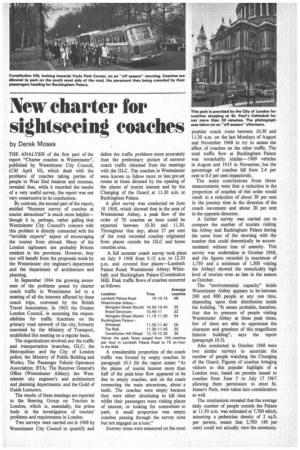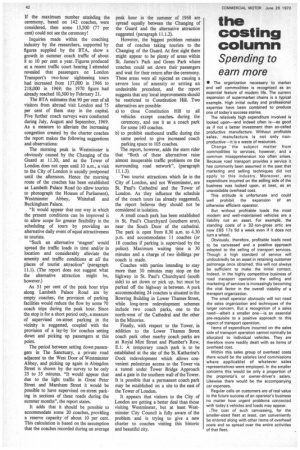New charter for sightseeing coaches
Page 43

Page 44

If you've noticed an error in this article please click here to report it so we can fix it.
by Derek Moses
THE ANALYSIS of the first part of the report "Charter coaches in Westminster", published by Westminster City Council, (CM April 10), which dealt with the problems of coaches taking parties of people to West End theatres and cinemas, revealed that, while it recorded the results of a very useful survey, the report was not very constructive in its conclusions.
By contrast, the second part of the report, entitled "Summer survey of coaches at tourist attractions" is much more helpful— though it is, perhaps, rather galling that Westminster City Council's concern with this problem is directly connected with the "invisible exports" aspect of encouraging the tourest from abroad. Many of the London sightseers are probably Britons resident in the provinces. However, they too will benefit from the proposals made by the Westminster city engineer's department and the department of architecture and planning.
In September 1964 the growing awareness of the problems posed by charter coach traffic in Westminster led to a meeting of all the interests affected by these coach trips, convened by the British Travel Association. In 1965 the Greater London Council, in assuming the responsibilities for traffic functions on the primary road network of the city, formerly exercised by the Ministry of Transport, established this meeting on a regular basis.
The organizations involved are: the traffic and transportation branches, GLC; the Metropolitan and the City of London police; the Ministry of Public Building and Works; The Passenger Vehicle Operators Association: BTA; The Receiver General's Office (Westminster Abbey); the Westminster city engineer's and architecture and planning departments; and the Guild of Guide Lecturers.
The results of these meetings are reported to the Steering Group on Tourism in London, which is, essentially, the prime body in the investigation of tourists' problems and requirements in London.
Two surveys were carried out in 1968 by Westminster City. Council to quantify and define the traffic problems more accurately than the preliminary picture of summer coach traffic obtained from the meetings with the GLC. The coaches in Westminster were known to follow more or less pre-set routes at times dictated by the opening of the places of tourist interest and by the Changing of the Guard at 11.30 a.m. at Buckingham Palace.
A pilot survey was conducted on June 18 1968, which showed that in the area of Westminster Abbey, a peak flow of the order of 70 coaches an hour could be expected between 10.30 and 11.30. Throughout that day, about 27 per cent of the total recorded coaches originated from places outside the GLC and home counties area.
A. full summer coach survey took place on July 9 1968 from 9.15 a.m. to 12.30 p.m. and covered four places—Lambeth Palace Road; Westminster Abbey; Whitehall; and Buckingham Palace (Constitution Hill). Peak traffic flows of coaches occurred as follows:
Average Location Time coaches
Lambeth Palace Road 10-10.15 48 Westminster Abbey:—
Abingdon Street (South} 10.30-10.45 35 Broad Sanctuary 10.45-11 32 Abingdon Street (North) 11.16-11.30 34 Buckingham Palace:— Whitehall 11.30-11.40 26 The Mall 11.30-11.45 30 Constitution H (West) 12.15-12.30 35 Hence the peak flows ranged from 140 coaches per hour in Lambeth Palace Road to 75 an hour in the Mall.
A considerable proportion of the coach traffic was formed by empty coaches. In paragraph 10.3 (b) the report states: "At the places of tourist interest more than half of the peak-hour flow appeared to be due to empty coaches, and on the roads connecting the main attractions, about a tenth. The coaches were empty because they were either circulating to kill time whilst their passengers were visiting places of interest, or looking for somewhere to park. A small proportion was empty coaches passing through the survey zone but not engaged on a tour."
Journey times were measured on the most popular coach route between 10.30 and 11.30 a.m. on the last Mondays of August and November 1968 to try to assess the effect of coaches on the other traffic. The total traffic flow at Buckingham Palace was remarkably similar-1909 vehicles in August and 1915 in November, but the percentage of coaches fell from 2.4 per cent to 0.5 per cent respectively.
The main conclusions from these measurements were that a reduction in the proportion of coaches of this order would result in a reduction of about 30 per cent in the journey time in the direction of the coach movement and about 20 per cent in the opposite direction.
A further survey was carried out to compare the number of tourists visiting the Abbey and Buckingham Palace during the same hour of the morning with the number that could theoretically be accommodated without loss of amenity. This survey was undertaken in October 1968, and the figures recorded (a maximum of 1,750 and a minimum of 1,300 visiting the Abbey) showed the remarkably high level of tourists even as late in the season as October.
The "environmental capacity" inside Westminster Abbey appears to be between 500 and 800 people at any one time, depending upon their distribution inside the building. "It seems probable, therefore, that due to pressure of people visiting Westminster Abbey at these peak times, few of them are able to appreciate the character and grandeur of this magnificent historic building", says the report (paragraph 10.5).
Also conducted in October 1968 were two similar surveys to ascertain the number of people watching the Changing of the Guard. Figures of coaches bringing visitors to this popular highlight of a London tour, based on permits issued to coaches from June 5 to July 17 1967 allowing them permission to enter St. James's Park, were taken into consideration as well.
The conclusions revealed that the average daily number of people outside the Palace at 11.30 a.m. was estimated at 7,700 which, assuming a pedestrian density of 2 sq.ft. per person, meant that 3,700 (48 per cent) could not actually view the ceremony. If the maximum number attending the ceremony, based on 142 coaches, were considered, then some 13,500 (77 per cent) could not see the ceremony!
Inquiries made within the coaching industry by the researchers, supported by figures supplied by the BTA, show a growth in summer coach traffic of about 8 to 10 per cent a year. Figures produced at a recent traffic court hearing I attended revealed that passengers on London Transport's two-hour sightseeing tours had increased from 137,000 in 1966 to 218,000 in 1969; the 1970 figure had already reached 10,500 by February 21.
The BTA estimates that 90 per cent of all visitors from abroad visit London and 75 per cent of them stay in the capital. Five further coach surveys were conducted during July, August and September, 1969. As a measure to alleviate the increasing congestion created by the charter coaches the report makes the following suggestions and observations: The morning peak in Westminster is obviously caused by the Changing of the Guard at 11.30, and as the Tower of London does not open until 10 a.m., a visit to the City of London is usually postponed until the afternoon. Hence the morning route of the coaches has been established as Lambeth Palace Road (to allow tourists to photograph the Houses of Parliament), Westminster Abbey, Whitehall and Buckingham Palace.
"It would appear that one way in which the present conditions can be improved is to allow scope for greater flexibility in the scheduling of tours by providing an alternative daily event of equal attractiveness to tourists.
"Such an alternative 'magnet' would spread the traffic loads in time and/or in location and considerably alleviate the amenity and traffic conditions at all the places of tourist attraction" (paragraph 11.1). (The report does not suggest what the alternative attraction might be, however.) As 51 per cent of the peak hour trips along Lambeth Palace Road are by empty coaches, the provision of parking facilities would reduce the flow by some 70 coach trips during the peak hour. Since the stop is for a short period only, a measure of supervised on-street parking in the vicinity is • suggested, coupled with the provision of a lay-by for coaches setting down and picking up passengers at this point.
The period between setting down passengers in The Sanctuary, a private road adjacent to the West Door of Westminster Abbey, and picking up again in Abingdon Street is shown by the survey to be only 25 to 35 minutes. "It would appear that due to the light traffic in Great Peter Street and Marsham Street it would be possible to have supervised on-street parking in sections of these roads during the summer months", the report states.
It adds that it should be possible to accommodate some 20 coaches, provi'ding a reserve capacity of about 10 per cent. This calculation is based on the assumption that the coaches recorded during an average peak hour in the summer of 1968 are spread equally between the Changing of the Guard and the alternative attraction suggested (paragraph 11.1.2).
However, the biggest problem remains that of coaches taking tourists to the Changing of the Guard. At first sight there might appear to be plenty of areas within St. James's Park and Green Park where coaches could set down their passengers and wait for their return after the ceremony. These areas were all rejected as causing a severe loss of amenity or setting an undesirable precedent, and the report suggests that any local improvements should be restricted to Constitution Hill. Two alternatives are possible: a) to close Constitution Hill to all vehicles except coaches during the ceremony, and use it as a coach park for some 140 coaches.
b) to prohibit eastbound traffic during the same period to give increased coach parking space to 105 coaches.
The report, however, adds the stern rider that "Both of these alternatives raise almost insuperable traffic problems on the surrounding road network", (paragraph 11.1.3).
Two tourist attractions which lie in the City of London, and not Westminster, are St. Paul's Cathedral and the Tower of London. As they influence the schedule of the coach tours (as already suggested), the report believes they should not be considered in isolation.
A small coach park has been established in St. Paul's Churchyard (southern arm), near the South Door of the cathedral. The park is open from 8.30 a.m. to 4.30 p.m. and accommodates 11 coaches (or 18 coaches if parking is supervised by the police). Maximum waiting time is 30 minutes and a charge of two Shillings per coach is made.
Coaches with parties intending to stay more than 30 minutes may stop on the highway in St. Paul's Churchyard (south side) to set down or pick up, but must be parked off the highway in between. A park accommodating 24 coaches is situated in the Bowring Building in Lower Thames Street, while long-term redevelopment schemes include two coach parks, one to the north-west of the Cathedral and the other in the Minories.
Finally, with respect to the Tower, in addition to the Lower Thames Street coach park other nearby coach parks are at Ro}'ial Mint Street and Plumber's Row, E.1. A temporary coach park is to be established at the site of the St. Katharine's Dock redevelopment which allows convenient pedestrian _access to the Tower via a tunnel under Tower Bridge Approach and a gate in the southern wall of the Tower. It is possible that a permanent coach park may be established on a site to the east of the Tower of London.
. It appears that visitors to the City of London are getting a better deal than those visiting Westminster, but at least Westminster City Council is fully aware of the problem • and is trying to give a new charter to coaches visiting this historic and beautiful city.






















































































































